
aul Owens started training and working with dogs in 1972. He has also practiced and taught yoga in the United States and India for over 40 years. Yoga and its integral philosophy of nonviolence has been a big influence on Paul’s dog training approach.
Paul has written three wonderful books: the best selling The Dog Whisperer: A Compassionate Nonviolent Approach to Dog Training, The Puppy Whisperer and The Dog Whisperer presents: Good Habits for Great Dogs. In addition, he has produced three Dog Whisperer DVDs, Volumes One and Two and Welcome Home! The Ultimate Guide for all Newly-Adopted Puppies & Dogs.
Paul specializes in the evaluation and behavior modification of aggressive dogs. He regularly volunteers his time for children bite prevention programs and monthly dog training seminars at shelters. He has appeared on numerous radio and television programs, including PBS’s Pets Part of the Family and the nationally syndicated Pet Files. His articles and interviews have appeared in several local and national magazines, including Self, Animal Wellness Magazine, Bark magazine, The Pet Press, The Cleveland Plain Dealer, LA Parent, The Burbank Leader, The Whole Dog Journal, The Yoga Journal, Alaskan Airlines Magazine and many others.
Paul has generously agreed to answer a few questions for My Dog’s Best Friend (see interview below) and given us permission to post two of his stories that we feel powerfully demonstrate the difference dogs can make in the lives of others they share their love with:
Paws for Peace: Melissa’s Story
Paws for Peace was an after-school violence prevention program Paul founded and directed during the 1990s and early 2000s, designed for elementary school children. Through Paws for Peace, children were taught the important connection of treating friends, family, and the environment with the same kindness and respect that we show to animals.
Passages: a canine prison program
Passages tells the story of a visit to a training session conducted by Paul’s friend, Mark Tipton, for a California canine prison program. Another wonderful example of dogs bringing love, joy, connection and the possibility of new beginnings.
My Dog’s Best Friend is honored to feature Paul’s wonderful work and spread his compassionate dog training methods.
Thank you Paul!
Q. In your Puppy Whispering video, you talk about how you switched from traditional to positive training methods in 1988 “… because for some reason my consciousness changed.“ Was there a specific incident, some kind of “epiphany” that led to that change?
A. I started practicing yoga in the early 70s. As the years went by, I found I no longer had any impulse to be confrontational with dogs or to punish or threaten them. I realized that I now looked at dogs as family members and friends.
The event I spoke about in the book described the feeling perfectly, where my brother had asked me to train his new dog. When he barked, I reflexively did a leash correction, because that muscle memory from years of repetitions had triggered. I immediately dropped the leash because I was shocked I had done such a thing.
Q. What do find to be the most persuasive argument when trying to get dog guardians to buy into the positive dog training philosophy?
A. Left brain approach: Don’t believe it until you can see it and do it yourself. Simply watch what the positive trainer does and listen to what the trainer says. If the dog responds exactly like the trainer says he or she will respond, the results speak for themselves.
Right brain approach: Your dog is your family member and friend. The way we treat our dogs is directly linked to how we treat ourselves, family, friends and others.
And,
Don’t do anything to your dog that you would be arrested for if you did the same thing with a human being.
Q. Despite all the advances in the dog training field in the last couple of decades, despite what all the top experts are now saying about training methods, there are still some (too many?) trainers out there who still tenaciously use those traditional methods you mention. Why do you think that is?
Q. In your Find a Dog Trainer article, you state that the traditional trainers are still the vast majority of trainers today. In the book The Tipping Point, Malcolm Gladwell talks about “that magic moment when an idea, trend, or social behavior crosses a threshold, tips, and spreads like wildfire.” Can you look into your crystal ball and tell us what needs to happen to reach that “tipping point” in the field of dog training when the proportions of positive and traditional trainers are reversed?
A. Ignorance is part of human nature. There will always be someone,, somewhere who will choose to treat themselves and others with insensitivity. Fortunately, I also happen to believe in the inexorable, infinite expansion of love. That’s also part of human nature.
Over the past couple of decades especially, more and more people have fostered and promoted peace and kindness in the world. It’s being done one puppy at a time.
Q. One thing I have noticed is that some of the traditional trainers have gotten pretty savvy about concealing their methods on their websites. Can you give us some tips on spotting the “closet traditional trainer?”
Q. As a trainer, what do you feel is the most challenging/difficult behavior issue to correct? How about for dog guardians?
Q. Can you describe to us what process you go through when you start working with a new client? How/Do you customize your training plans?
A. I have clients make a list of all the things they want their dogs to be able to do, and a list of all the behaviors they don’t want. If they don’t know what they want, the dog can’t figure it out either.
I get a history, based on my 9 Ingredients Model and then do an evaluation of the dog and the environment (see Realistically Doable article). When I visit, I go right down the list and show people exactly what to do, how to do it and have them practice the methods while I’m there. I send a comprehensive step-by-step review of the session and then do follow-ups if the people want.

I believe nonviolence fosters nonviolence. Because of the link between dog and human behavior, nonviolent dog training contributes to helping build a world of peace for humans and dogs. When people, especially children, are successful using nonviolent methods with animals, they feel good about themselves and they are encouraged to have a kinder, more positive attitude with their friends, family, and the environment.
Paul Owens
Paws for Peace: Melissa’s Story
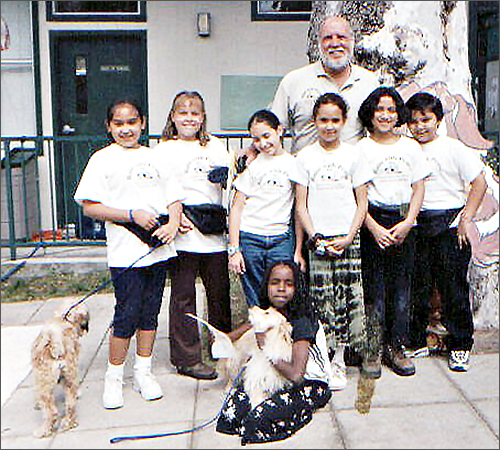
A group of happy Paws for Peace trainers.
Photograph courtesy of Paul Owens.
There were 10 students in class, all considered “at-risk.” Some were diagnosed with attention deficit disorder and on medication, most lived in poverty, in dangerous neighborhoods, and a few, like Melissa,* lived with an aunt or grandmother rather than parents.
Melissa was in the 4th grade. When she first walked into class, I was struck how drawn and colorless her face was. She walked with a kind of vacant stare, always looking out of the corner of her dark eyes and never looking you in the face. She didn’t smile. If you approached her or reached out to touch her arm, she would quickly withdraw and back away. The teachers hoped our animal-assisted therapy program, Paws for Peace, might allow her to reach out to the world a little more.
The first day of class was held without dogs, to explain the program to the children and distribute handouts. On the second day of class, the children were introduced to their dogs. Most dogs were rescues from the Glendale Humane Society in California. Melissa’s dog was a five-month-old Whippet named Devo.
At first Melissa didn’t know what to make of the jumping, barking bundle of energy, but with a lot of gentle encouragement, she hesitantly reached out and began to pet him. Just like the training process with dogs, we let Melissa proceed at her own comfortable speed and by the end of the next day Melissa was sitting on the ground allowing Devo to jump onto her lap and off again.
All through week two, most of the children in class progressed rapidly. Two decided they weren’t really interested in the responsibilities of feeding and cleaning up poop and by week three, they were gone. But Melissa never missed a class. The children had the dogs sitting and lying down, staying in place and going to their beds. They learned they could get their dogs to do all of these things without having to hit, kick, shock, shake, or jerk them on a leash. They trained and groomed their dogs with kindness and affection. They listened to their dog’s heartbeat through a stethoscope when a guest veterinarian visited and learned all about keeping dogs healthy.
The high point of each class, however, was the daily walk. The children were taught how to hold the leash, have their dog sit before crossing the street (it was a low traffic cul-de-sac), and while walking, occasionally ask their dog to come when called. But children being children and dogs being dogs, every walk inevitably turned into a run. Seeing ears flapping, tails wagging and children joyously yelling while running down the hill after their dogs summed up the Paws for Peace program perfectly. For some of these children, Paws for Peace provides rare opportunities for them to actually be children. They can have fun in a safe environment.
Now Melissa hadn’t seen or spoken with her mother for many months because she was incarcerated, and, as a result, Melissa lived with her grandmother. Parents, guardians, and teachers are always invited to watch the classes. And there, at the end of the third week of classes, a woman appeared and stood and briefly watched the class from a few yards away. It was Melissa’s mother.
While I was instructing another student, the mother walked straight up to Melissa, who was seated on the ground with Devo. I couldn’t hear what she said but Melissa started to cry and the mother walked away. My assistant instructor, Stacy, put her arms around the sobbing little girl and held her. Stacy gave me a sign and the two of them left class for a walk. A few minutes later they returned and Melissa went back to petting little Devo. Stacy signaled everything was OK and class continued.
After class, I made a point to praise Melissa for her courage and bravery, and she allowed me to give her a little hug. When the children had all left, Stacy related what had happened. Melissa’s mother never said hello or acknowledged her. She had walked up to this sweet little girl and said, “I think your dog is ugly.” Then she left.
Little Melissa was heartbroken. I asked Stacy what she said to console her. She said, “I didn’t really know what to say. So I asked her if she thought Devo was beautiful. She nodded her head yes. Then I asked her if she loved Devo. She managed to whisper a yes. So I said ‘it really doesn’t matter what other people think sometimes. All that’s important is that you think Devo is beautiful and that you love him … and Devo loves you.’”
My heart was in my throat and I smiled and thanked Stacy profusely. She was perfect.
From that day on, Melissa volunteered to clean up after class and to walk the dogs to the cars. At graduation, this shy, wonderful little girl got up in front of forty people and showed them what she had learned in class. She asked Devo to sit, lie down, come when called and stay. And Devo did it all. When she finished, Melissa knelt down to hug Devo and give him a treat. And the smile never left her face. For a moment there was silence and then everyone applauded and cheered. We all had tears in our eyes.
It is for children like Melissa that the Paws for Peace program was created. One-by-one, with the help of animals, each child learns about his or her own self-worth. They learn that there are other ways to get along with family, friends, and the environment — ways that can replace fear, anger, and frustration. They learn the value of practicing empathy, treating themselves and others with respect, and that kindness and compassion work.
* I’ve changed Melissa’s name to protect her privacy.

Both the dogs’ and the handlers’ responses were nothing short of amazing. These were happy dogs. These were happier men. In five short weeks, using strictly positive training methods, the men had learned to be responsible for their dogs and treat them with kindness and respect. I saw them work together in teams without confrontation and without competition. These guys were good dog trainers.
Paul Owens
Passages: a canine prison program
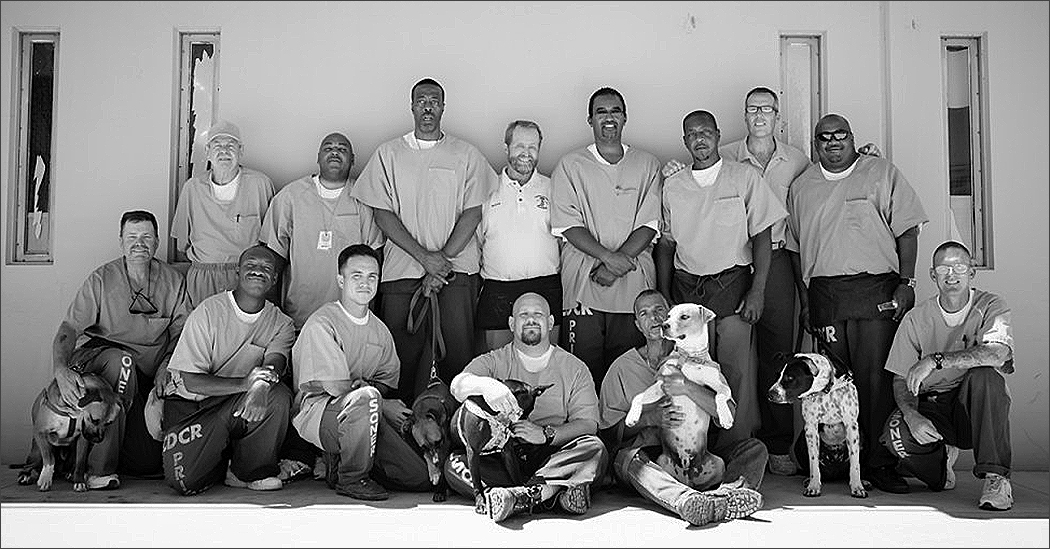
Left to right standing: Gerald, De Angelo, Donnell, Mark, Ed, Dennis, Jack, Travielle.
Sitting: John, Marcus, Christopher, Jon, Oliver, Christopher
Dogs: Rendell, Chuey, Shelby, Eddie, Oreo.
Missing: Abdul
Photograph courtesy of Paul Owens.
Prison is different from jail. I spent a three-day, Easter vacation in jail in my early twenties for a youthful recreational offense, but prison is different. There’s an ever-present, over-the-shoulder watchfulness and palpable sense of vulnerability. The stone walls and iron bars define the hardness that is felt the moment you enter and the doors lock behind you.
Last month, I and two of my Teacher Trainees, Rachel Heald and Glenda Herrin were invited to attend a canine prison program taught by my good friend, professional dog trainer Mark Tipton, director of Angeldogs Training in Santa Clarita, California. The program was initiated by an obviously very caring individual, Captain Crystal Wood of the State of California’s Department of Corrections and Rehabilitation. It was sponsored by Karma Dog Rescue, a terrific non-profit organization that saves at-risk dogs from high-kill Los Angeles area shelters.
This new twelve-week program consisted of five rescued dogs and fourteen prisoners who ranged in age from mid-twenties to over sixty. Almost all of these men were sentenced to life without possibility of parole. Obviously, the dogs didn’t know this.
Classes were held three days a week for sessions of up to an hour. Mark held two weeks worth of preparation classes before any participants were introduced to their dogs. He talked about learning theory, body language, handling, care and training.
Participants accepted responsibility for the care, safety and training of the dogs. The dogs lived with five primary trainers during the day and slept in protected outdoor kennels at night. The benefits for the dogs were to not only save them from euthanization, but to help improve their quality of life by providing them with physical, mental and emotional stimulation through socialization and training. The stated behavioral goal: have each dog pass the AKC Canine Good Citizenship Test. The goal for the men: respect, responsibility, stress reduction and improved self worth. It could be summed up with what Mark tells the program participants: “The way we treat animals is directly linked to how we treat ourselves and others.”
I was introduced to each of the men while they entered the large auditorium. They were very polite and there was a genuine sense of warmth and “we’re happy to meet you.” While I was talking with them, it reminded me of something a good friend told me some 40 years ago: “Sometimes you’ll be in a situation where you’ll feel like you’re the actor, and the director and a member of the audience, all at the same time. That’s present-moment awareness.” I can honestly say, at that moment, I was uniquely aware of the situation. But when the dogs entered, heads turned and everything seemed to kind of wake up and come alive. The atmosphere seemed, well, suddenly lighter and less threatening.
After a few moments, Mark gathered everyone together and class began. Under his expert guidance, I watched these men ask their dogs to sit, lie down, stay, come and leave treats when thrown on the floor. They asked them to heel, each dog staying by their trainer’s side while being walked across the auditorium. You could see how Mark’s curriculum was expertly set up to step-by-step prepare both handler and dog for the CGC test.
Both the dogs’ and the handlers’ responses were nothing short of amazing. These were happy dogs. These were happier men. In five short weeks, using strictly positive training methods, the men had learned to be responsible for their dogs and treat them with kindness and respect. I saw them work together in teams without confrontation and without competition. Their training skills were beyond what I could imagine in such a short period of time. These guys were good dog trainers.
After the class, I congratulated each one of them on their work. I asked one of the men what the prison program had meant to him and he said, “You know, I was surprised. I’ve been here so long I didn’t think it was possible, but I feel,” and he hesitated a moment, and then said, “bigger.” I said, “like your heart expanded?” And he lit up and said, “Yeah!”
Later, Captain Wood told us a story. She explained that, on any given day, there could be several hundred prisoners in the courtyard. She said that over time, each and every guard learned that whenever the yard became quiet, tensions would rise because something bad was about to happen. Everyone would then be on highest alert. One day recently that’s exactly what happened. Things became quiet and all the guards came to attention, looking for signs of trouble. What was happening? It turns out that Mark and his trainers had come outside to get their pictures taken with their dogs. Every prisoner in the yard stopped what they were doing. They simply wanted to see the dogs. The Captain said she had never seen anything like that in her more than 20 years working in the prison system.
I want to list every one of their names so that they can have one more affirmation that what they are doing is making a difference and a meaningful and wonderful contribution to the world. Further, I cannot express deeply enough the admiration I have for the job Mark is doing and what he and his students have accomplished. Heartiest congratulations to Karma Rescue for their indefatigable efforts in helping “create a compassionate society which provides safety, refuge and protection for all animals.” And kudos to Captain Wood and her staff for their professionalism, guidance and compassion. This program represents the very best of what the canine-human bond has to offer.
Good job one and all!
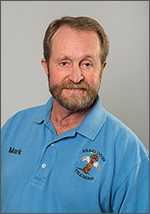
Mark Tipton
Photograph courtesy of Paul Owens.
LEARN MORE ABOUT THE WELCOME HOME! ULTIMATE GUIDE
Welcome Home! Ultimate Guide for all newly adopted Puppies and Dogs
By Paul Owens
Education and Motivation are the keys that will have a direct impact on dogs being returned to shelters and rescues, dogs being euthanized and the reduction of accidents for both dogs and people, especially the number of children bitten each year.
Education includes how to care for and properly train and socialize dogs and how to create safer home environments. By teaching people exactly what to do and how to do it, we can make a definitive impact on the number of dogs dying, the number of children bitten, and greatly reduce the accompanying financial toll.
But education is only one part of the solution. People need to be motivated to act. The Welcome Home! Ultimate Guide demonstrates just how effective force-free, reward-based training is and how much fun using these methods can be, for both the dog and the adopter.
The Welcome Home! Ultimate Guide for all newly adopted Puppies and Dogs will greatly improve the quality of life of millions of puppies and dogs AND their adoptive families.
This Ultimate Guide consists of an hour long program, plus a 12-page Quick Start Guide packed with all the basic information you need to keep your new arrival safe and get his or her training off to the best start possible. $19.95
CONTACT: info@originaldogwhisperer.com 800.269.3591
THE THREE PRINCIPLES OF POSITIVE, FORCE-FREE DOG TRAINING
Prevention/Management: creating an environment for safety and success. In other words, keeping dogs safe and “under threshold.” Safety is always most important. This means an environment where fears and unwanted behaviors aren’t triggered and a dog really wants to learn. Distance away from distracting, threatening or “scary” stimuli is the key. Proper use of leashes (tethers), baby gates, crates and exercise pens are the tools. Prevention is the foundation for safe and successful results.
Counter-conditioning/ desensitization: Changing the way dogs feel about things. We do that by associating anything new, like a person or another dog (or unexpected sounds!) with high-valued treats like chicken and cheese and a happy attitude. We introduce things gradually, at a distance and a pace they can handle, like progressing through elementary school, then high school and so on.
Substitution: Teaching dogs the behaviors you want instead of trying to stop the behaviors you don’t want. Throughout the day, CAPTURE the 5 Magnet Game behaviors. These behaviors are “substitutes” for unwanted behaviors. Capture means acknowledging with praise and treats the behaviors you are trying to grow: sit, down, pick up toys, going to their beds and, the most important, the “look” behavior. We also practice asking for behaviors, which is called “cueing.” Some of the substitute behaviors we do include: sit and lie down, stay with progressions and the 3 “find it” games. You can do 3 or 4 of each of these exercises within 1 to 10 minutes, and that’s it. Do several sessions throughout the day.
The trick is to have the desired behavior firmly visualized in your mind. What is the end result? What do you want them to do instead? Then it’s just a matter of step-by-step progression through grade school and then high school levels … which means asking for longer periods of time in a position, gradually adding distractions, increasing distance and it all culminating in reliability.
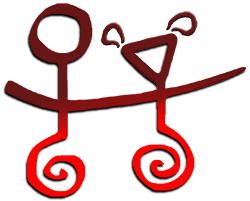
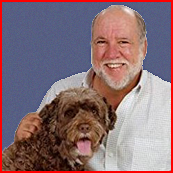
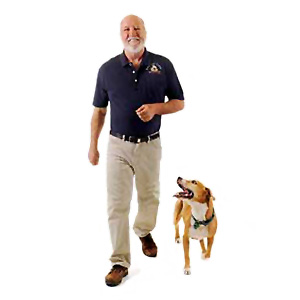
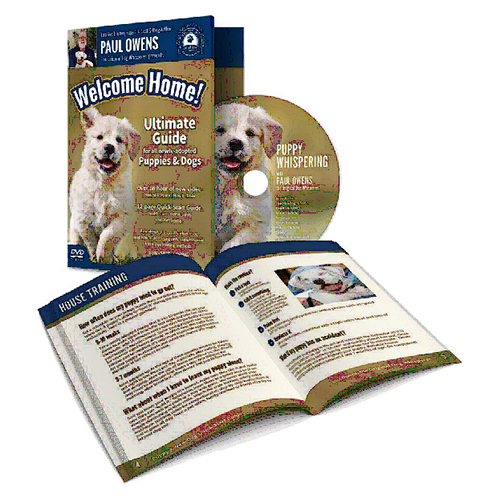
0 Comments